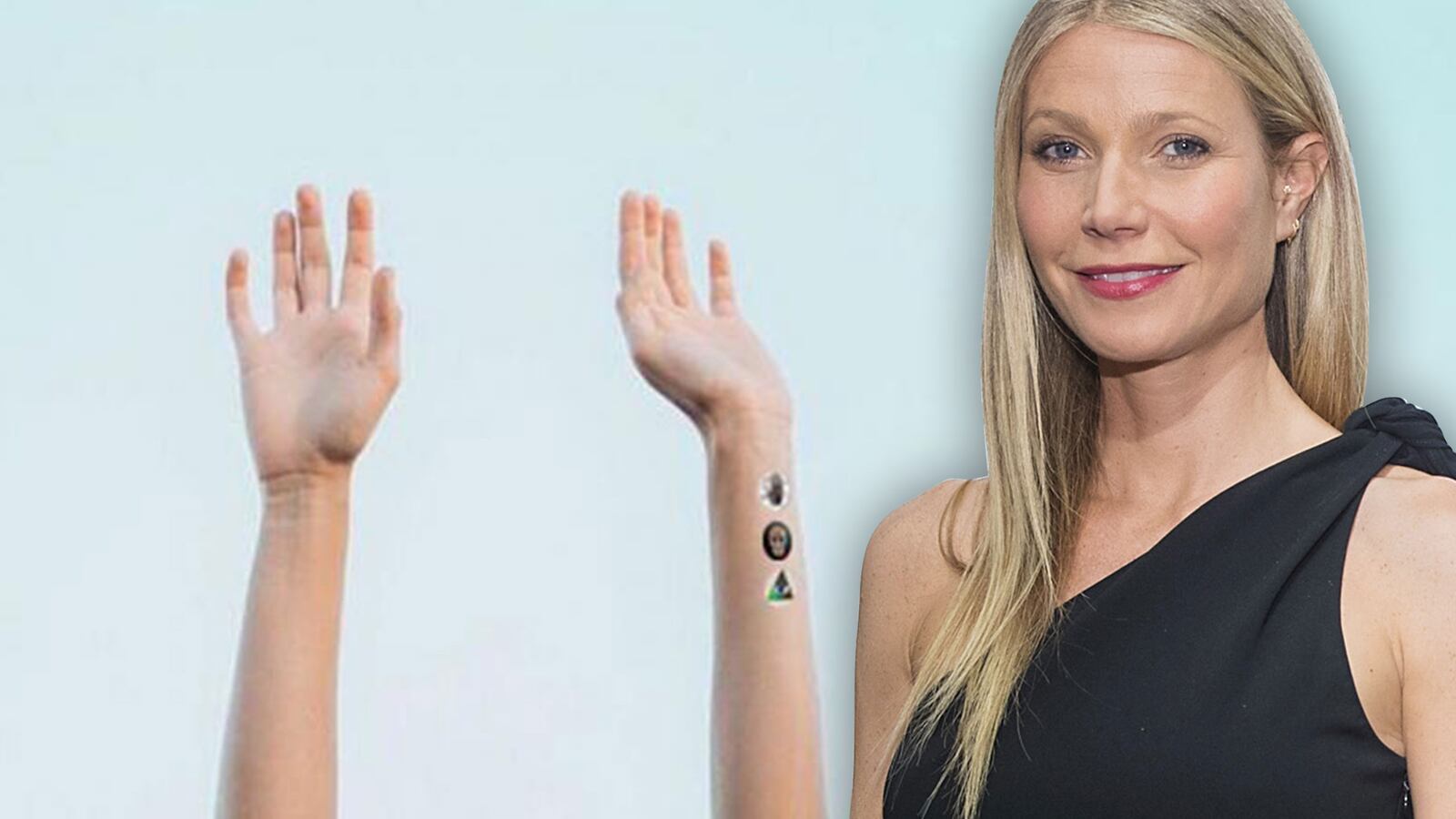Gwyneth Paltrow, Oscar-winner and dubious lifestyle guru, is under fire again. At issue this time: Body Vibes, the small stickers that can be placed on the upper arms to “promote healing,” “rebalance energy frequencies,” “smooth out physical tension and anxiety,” and “boost cell turnover.”
Paltrow wasn’t criticized because her website Goop was again peddling a product that couldn’t prove any of its claims or outright dangerous. Or because one—“boosting cell turnover”—sounded like something that no one should ever want. Rather she was slapped for the biological basis on which these claims were made: Paltrow said the healing power of Body Vibes came from NASA space science. Its inventors had supposedly used “the same conductive carbon material that NASA uses to line space suits so they can monitor an astronaut’s vital [signs] during wear.” According to GOOP, the technology developed by NASA used a “biofrequency that resonates with the body’s natural energy field.”
NASA immediately debunked Paltrow’s claim, stating that spacesuits “do not have any conductive carbon material lining.” (And Goop subsequently removed it.)
Although many have been quick to dismiss Goop’s latest miracle cure, Body Vibe stickers do offer the same thing that alternative healers typically promise—a chance to benefit from the placebo response.
One of the first demonstrations of the power of the placebo took place on the battlefields of World War II, where a nurse ran out of morphine. Unable to tell a wounded soldier that she had nothing to treat his pain, she said the saltwater she had just given him was actually morphine. To her surprise, the soldier’s pain disappeared. Researchers have since found that people can learn to release their own endorphins: powerful, morphine-like, pain-relieving chemicals made by the pituitary gland and hypothalamus. Indeed, the biological basis of pain relief from acupuncture has nothing to do with where the healer puts the needles—or even whether the needles enter the skin—and everything to do with some patients releasing their own endorphins.
The placebo response isn’t limited to pain relief.
In 1957, John Imboden and colleagues at Johns Hopkins School of Medicine performed a landmark experiment. They administered a series of psychological tests to military personnel working at Fort Detrick, Maryland. A few months later, an influenza pandemic swept across the camp. Imboden found that recruits who were depressed had symptoms of influenza that lasted longer and were more severe than those in recruits who weren’t depressed. In other words, mood determined illness. “The mind,” wrote John Milton in Paradise Lost, “can make a heaven of hell and a hell of heaven.”
In 1975, Robert Ader and Nicholas Cohen from the University of Rochester School of Medicine took Imboden’s observations one step further. They found that rats given cyclophosphamide (an immune-suppressive drug) in saccharin-flavored water developed an inability to respond to foreign proteins. Weeks later, their immune systems recovered. That wasn’t surprising. What was surprising was that when these same rats were later given saccharin-flavored water only, they again had a lesser immune response. The rats, by pairing the taste of saccharin with an immune-suppressive drug, had learned to suppress their own immune systems. Amazing.
The next question: Could researchers teach people to suppress their immune response? Again, Robert Ader took the lead. Working with a teenager with the autoimmune disease lupus, he paired cyclophosphamide with a distinct taste (cod liver oil) and smell (rose perfume). Like the rats, the boy learned to suppress his immune response, requiring less-frequent dosing of the steroid necessary to control his disease. Other researchers replicated Ader’s findings. And it worked both ways; not only could people learn to suppress their immune responses, they could learn to enhance them.
Which brings us back to Gwyneth Paltrow’s Body Vibes. If people believe that Body Vibe patches are giving them more energy or relieving tension, who’s to say that this belief can’t result in healing? If people can learn to release their own endorphins or up-regulate or down-regulate their own immune systems, why can’t Body Vibe patches offer some benefit? And, unlike antidepressants or mood-elevating drugs, these patches have no side effects.

Another thing. Although the cost of Body Vibe patches—$60 for a pack of 10—is no doubt logarithmically greater than the cost of manufacture, according to the theory of cognitive dissonance, the more expensive the better. This concept was first tested at a racetrack in the 1960s. Researchers asked bettors to rate their horse as they walked toward or away from the betting window. Bettors faced two conflicting facts: 1) Any horse could win the race, 2) I bet a lot of money on only one horse. To resolve the conflict, bettors rated their horse much higher after placing their bets. (Here’s that study.) In another, researchers from MIT tested the capacity of two sugar pills to relieve pain. One group was told that the pill cost 10 cents, the other that it cost $2.50. Participants experienced less pain with the pill that was said to be more expensive.
But is it ethical for Body Vibe’s marketers to deceive?
In fairness, all practitioners—mainstream or otherwise—employ some form of deception. They know that a positive attitude, reassuring demeanor, and air of competence are important. “We use the placebo effect all the time,” says Art Caplan, professor of bioethics at New York University’s Langone Medical Center. “I’ve got a bowtie. I wear a white coat. You come to a big building that looks pretty impressive. I expect someday to see billboards go up in cities that say we have a really big machine and it makes a lot of noise and we don’t know how it works but you can only get it from us so come on down.”
Indeed, it would be more honest if mainstream doctors walked into a patient’s room and said, “Look, we will definitely know more about how to treat your illness a hundred years from now. Frankly, I suspect doctors in the future will look back on some of the things that we’re doing today and laugh. Although our understanding of many diseases is excellent, for some we’re just treading water, and for others we’re completely lost.” No clinicians (in their right mind) say this. From the days of shamans and witch doctors to the modern-day physician, everybody has their props, their deceptions. In fact, studies have shown that when physicians claim that one particular medicine will be more effective, the patient will later perceive that medicine as being more effective.
The line that cannot be crossed, however, is recommending placebo therapies that are potentially harmful. Unfortunately, in several instances, Goop has crossed that line, including touting vaginal steaming with mugwort to “balance female hormone levels” and “cleanse the uterus,” which, apart from the fact that mugwort isn’t a hormone and vaginal steam (absent pressure) will never reach the uterus, could cause burns or bacterial infections. Or promoting placing $66 jade eggs the size of golf balls in the vagina in hopes of boosting orgasms, enhancing kidney strength, improving physical appearance, and increasing vaginal tone, hormonal balance, and feminine energy—as well as the risk of bacterial infections, including toxic-shock syndrome. Or even cleansing the colon with enemas to remove toxins, boost energy, and enhance the immune system. These have no proven benefit in otherwise healthy people, and can cause dehydration, infections, vomiting, and, worst of all, bowel perforations.
Although Gwyneth Paltrow should be held accountable for “therapies” that are potentially dangerous, Body Vibe patches don’t fall into that category. And Paltrow could reasonably argue that believing that you are benefiting from the patches might trigger a physiological response that is actually beneficial. Belief is a powerful medicine.
Paul A. Offit is the director of the Vaccine Education Center at the Children’s Hospital of Philadelphia and the author of Do You Believe in Magic? The Sense and Nonsense of Alternative Medicine (HarperCollins, 2013).






